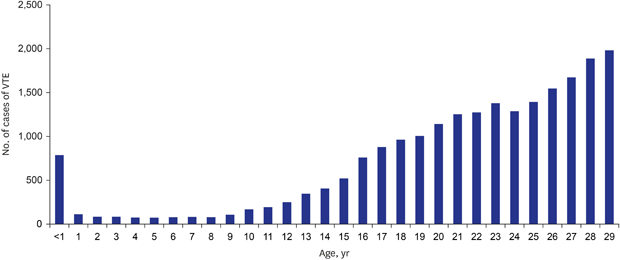1. Nowak-Göttl U, Janssen V, Manner D, Kenet G. Venous thromboembolism in neonates and children--update 2013. Thromb Res. 2013; 131 Suppl 1:S39–S41.
2. Chalmers E, Ganesen V, Liesner R, Maroo S, Nokes T, Saunders D, et al. Guideline on the investigation, management and prevention of venous thrombosis in children. Br J Haematol. 2011; 154(2):196–207.
3. Setty BA, O'Brien SH, Kerlin BA. Pediatric venous thromboembolism in the United States: a tertiary care complication of chronic diseases. Pediatr Blood Cancer. 2012; 59(2):258–264.
4. Raffini L, Huang YS, Witmer C, Feudtner C. Dramatic increase in venous thromboembolism in children's hospitals in the United States from 2001 to 2007. Pediatrics. 2009; 124(4):1001–1008.
5. van Ommen CH, Heijboer H, Büller HR, Hirasing RA, Heijmans HS, Peters M. Venous thromboembolism in childhood: a prospective two-year registry in The Netherlands. J Pediatr. 2001; 139(5):676–681.
6. Andrew M, David M, Adams M, Ali K, Anderson R, Barnard D, et al. Venous thromboembolic complications (VTE) in children: first analyses of the Canadian Registry of VTE. Blood. 1994; 83(5):1251–1257.
7. Schmidt B, Andrew M. Neonatal thrombosis: report of a prospective Canadian and international registry. Pediatrics. 1995; 96(5 Pt 1):939–943.
8. Sandoval JA, Sheehan MP, Stonerock CE, Shafique S, Rescorla FJ, Dalsing MC. Incidence, risk factors, and treatment patterns for deep venous thrombosis in hospitalized children: an increasing population at risk. J Vasc Surg. 2008; 47(4):837–843.
9. Chopra V, Anand S, Hickner A, Buist M, Rogers MA, Saint S, et al. Risk of venous thromboembolism associated with peripherally inserted central catheters: a systematic review and meta-analysis. Lancet. 2013; 382(9889):311–325.
10. Athale U, Siciliano S, Thabane L, Pai N, Cox S, Lathia A, et al. Epidemiology and clinical risk factors predisposing to thromboembolism in children with cancer. Pediatr Blood Cancer. 2008; 51(6):792–797.
11. Kim L, Kim JA, Kim S. A guide for the utilization of Health Insurance Review and Assessment Service National Patient Samples. Epidemiol Health. 2014; 36:e2014008.
12. Kim DS. Special issue on the national health care system of South Korea. Soc Work Public Health. 2010; 25(2):125–126.
13. Kim DS. Introduction: health of the health care system in Korea. Soc Work Public Health. 2010; 25(2):127–141.
14. Young G. Anticoagulants in children and adolescents. Hematology (Am Soc Hematol Educ Program). 2015; 2015(1):111–116.
15. Monagle P, Cuello CA, Augustine C, Bonduel M, Brandão LR, Capman T, et al. American Society of Hematology 2018 Guidelines for management of venous thromboembolism: treatment of pediatric venous thromboembolism. Blood Adv. 2018; 2(22):3292–3316.
16. Mahajerin A, Croteau SE. Epidemiology and risk assessment of pediatric venous thromboembolism. Front Pediatr. 2017; 5:68.
17. Lipay NV, Zmitrovich AI, Aleinikova OV. Epidemiology of venous thromboembolism in children with malignant diseases: a single-center study of the Belarusian Center for Pediatric Oncology and Hematology. Thromb Res. 2011; 128(2):130–134.
18. Sabapathy CA, Djouonang TN, Kahn SR, Platt RW, Tagalakis V. Incidence trends and mortality from childhood venous thromboembolism: a population-based cohort study. J Pediatr. 2016; 172:175–180.e1.
19. Kerlin BA, Stephens JA, Hogan MJ, Smoyer WE, O'Brien SH. Development of a pediatric-specific clinical probability tool for diagnosis of venous thromboembolism: a feasibility study. Pediatr Res. 2015; 77(3):463–471.
20. Hong J, Lee JH, Yhim HY, Choi WI, Bang SM, Lee H, et al. Incidence of venous thromboembolism in Korea from 2009 to 2013. PLoS One. 2018; 13(1):e0191897.
21. Lee LH, Gallus A, Jindal R, Wang C, Wu CC. Incidence of venous thromboembolism in Asian populations: a systematic review. Thromb Haemost. 2017; 117(12):2243–2260.
22. Lee S, Youn JH, Lim JY, Cheuh HW, Lee JM, Suh JK, et al. Childhood venous thromboembolism in Yeungnam region in Korea: multicenter study. Clin Pediatr Hematol Oncol. 2018; 25(1):43–49.
23. Amankwah EK, Atchison CM, Arlikar S, Ayala I, Barrett L, Branchford BR, et al. Risk factors for hospital-sssociated venous thromboembolism in the neonatal intensive care unit. Thromb Res. 2014; 134(2):305–309.
24. Choi HS, Kim HJ, Kang HJ, Lee JW, Shin HY, Park HJ, et al. Thromboembolism in children with cancer: a retrospective multicenter study in Korea. J Thromb Thrombolysis. 2019; 47(4):558–565.
25. Ishola T, Kirk SE, Guffey D, Voigt K, Shah MD, Srivaths L. Risk factors and co-morbidities in adolescent thromboembolism are different than those in younger children. Thromb Res. 2016; 141:178–182.
26. Jaffray J, Mahajerin A, Young G, Goldenberg N, Ji L, Sposto R, et al. A multi-institutional registry of pediatric hospital-acquired thrombosis cases: The Children's Hospital-Acquired Thrombosis (CHAT) project. Thromb Res. 2018; 161:67–72.










 PDF
PDF Citation
Citation Print
Print






 XML Download
XML Download